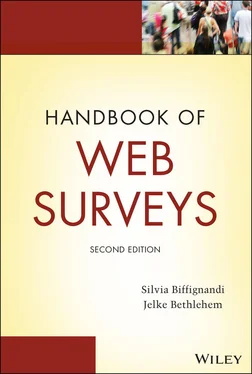Overall response rates do not give information regarding the response propensity of different respondent subgroups (late respondents versus early respondents, and sociodemographically different subgroups) or on respondent behavior.
Response rates are anyway becoming low, and there is a need to investigate the reasons. Incentive is thought as a possible solution. Göritz (2006, 2010, 2015) and Brown et al. (2016) suggest a generally positive effect of incentives in web surveys. Singer and Ye (2013) conclude that in all survey modes, prepaid cash incentive is the most effective. In this case, it is required to use a mode rather than web to contact respondents. If the e‐mail contact option is adopted, Dillman, Smyth, and Christian (2014) comment that electronic incentive sent to all sample member is likely the best option. With respect to sampling error, due to imperfect frames in web surveys, traditional probabilistic samples are in many cases not easy to implement. Therefore, it is not possible to compute the sampling error, as the theory of statistical inference does not apply.
As consequence of this new paradigm, attention is going at:
How to face decreasing response rates. Possible solutions may be:Keeping respondents focused on the relevant parts of the computer screen and keeping distraction to a minimum can help to get completed questionnaire. To accomplish this task, studies based on eye‐tracking analysis are to be carried out.An interesting strategy for improving response rates is to use mixed‐mode surveys (see Chapters 3and 9). However, new problems arise with the mixed approach, since mode effects are to be considered in analyzing survey results. Occurrence and treatment of mixed‐mode effects need further investigation. Chapter 9is about it.
How to use paradata (i.e., data collected during the interviewing process). Increasing attention is going to be devoted to the analysis of this type of data. In particular, they help to identify typologies of response behavior explaining the potential variations in participation in web‐based surveys and providing a valuable insight into understanding nonresponse and various aspects of response behavior. From the methodological point of view, behavioral analyses rely to the Cognitive Aspects of Survey Methodology Movement (CASM), and, in many empirical studies, the theory of planned behavior (TPB) model is applied (Ajzen, 1991). The main objective is to obtain a more comprehensible picture on how intentions form. For example, based on the TPB, two alternative models were empirically tested, in which the roles of trust and innovativeness were theorized differently—either as moderators of the effects that perceived behavioral control and attitude have on participation intention (moderator model) or as direct determinants of the attitude, perceived behavioral control, and intention (direct effects model).
How to get representative web surveys and/or panels? Many access panels consist of volunteers, and it is impossible to evaluate how well these volunteers represent the general population. In any case, they represent a non‐probability sample. Recent research attempts to tackle the task of how to apply probabilistic recruitment to panels and how to draw inferences from them are present in recent literature. One approach to correct for a lack of representativity is, for example, to apply propensity score methodology (Steinmetz et al., 2014). Propensity scores serve to reweight web survey results.
Generally speaking the methodology and quality of data collected in area of socioeconomics could greatly benefit by:
1 The development of suitable estimation methods aimed at capturing the bias and specific variance connected with the frame characteristics and participation process of this type of survey;
2 Research, principally based on experimental designs, allowing the effects of various factors to be tested (for example, the effects of different types of question structure, various contact modes, etc.);
3 Research, based on behavioral models, that allows response and participation processes to be analyzed and modeled in the context of the individual behavior of survey respondents.
The Italcementi Group is a large Italian company. The following data are about the situation when the study took place. With an annual production capacity of approximately 75 million tons of cement, it is the world's fifth largest cement producer. The group had companies in 22 countries around the world. Italcementi regularly monitors, by means of a mixed‐mode survey, the working conditions and working climate in the company. As regards the survey data is collected part by web and part by paper questionnaire forms.
The target population consists of all employees of all companies belonging to the Italcementi Group around the globe. With no sample selection, all employees are invited to participate in the survey. Thus, in principle it is a census and not a survey. There are no inference issues. Statistics computation is simply from the data.
Nonresponse can be a problem in surveys. Some people may fail to complete the survey questionnaire because they could not be contacted (despite several attempts), they refused to cooperate, or they were not able to answer the questions. This may lead to biased estimates of population characteristics. Nonresponse is not a big problem in the Italcementi survey. In many countries, almost everyone participates. See also Table 2.1.
The first step in the survey process is the design of the questionnaire. In fact, there are two questionnaires: one for blue‐collar employees and one for white‐collar employees. Italcementi Group as a whole, the company to which the employee belongs, and the specific location of the company cover the three main sections of the questionnaire. In addition, a section with questions about personal characteristics is included. The paper questionnaire for white‐collar employees is 8 pages long, while that for blue‐collar employees is 6 pages.
Table 2.1 Response rates of the Italcementi survey by country
| Country |
Overall response rate (%) |
White‐collar response rate (%) |
Blue‐collar response rate (%) |
| Albania |
91.9 |
— |
— |
| Bulgaria |
51.9 |
59.8 |
46.9 |
| Dubai |
100.0 |
— |
— |
| Egypt |
48.9 |
66.1 |
50.4 |
| France/Belgium |
44.7 (F) 51.7 (B) |
65.6 |
38.1 |
| Gambia |
90.7 |
— |
— |
| Greece |
52.3 |
79.7 |
31.2 |
| India |
94.1 |
94.3 |
94.0 |
| Italia |
48.6 |
65.2 |
30.5 |
| Kazakhstan |
66.7 |
61.8 |
68.2 |
| Morocco |
64.4 |
67.4 |
62.9 |
| Mauritania |
98.7 |
— |
— |
| North America |
43.3 |
76.3 |
21.9 |
| Singapore |
75.0 |
— |
— |
| Spain |
53.7 |
66.2 |
45.1 |
| Sri Lanka |
65.5 |
— |
— |
| Thailand |
78.2 |
84.1 |
72.7 |
| Turkey |
78.6 |
79.6 |
77.9 |
| Total |
54.7 |
— |
— |
The management committee of the enterprise group discusses at first the new survey. Next, by means of cognitive interviews, the questionnaire is tested. After approval of the questionnaire, fieldwork can start. A letter on the intranet announces the survey. The Enterprise Group CEO signs it. The letter distribution is also as part of pay packets. Moreover, the survey is announced on the company notice boards.
Читать дальше












